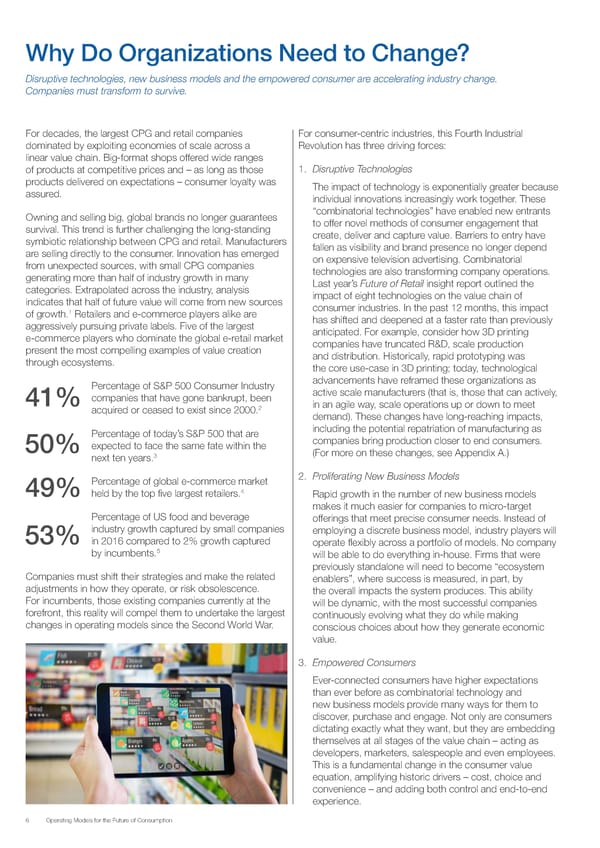Why Do Organizations Need to Change? Disruptive technologies, new business models and the empowered consumer are accelerating industry change. Companies must transform to survive. For decades, the largest CPG and retail companies For consumer-centric industries, this Fourth Industrial dominated by exploiting economies of scale across a Revolution has three driving forces: linear value chain. Big-format shops offered wide ranges of products at competitive prices and – as long as those 1. Disruptive Technologies products delivered on expectations – consumer loyalty was The impact of technology is exponentially greater because assured. individual innovations increasingly work together. These Owning and selling big, global brands no longer guarantees “combinatorial technologies” have enabled new entrants survival. This trend is further challenging the long-standing to offer novel methods of consumer engagement that symbiotic relationship between CPG and retail. Manufacturers create, deliver and capture value. Barriers to entry have are selling directly to the consumer. Innovation has emerged fallen as visibility and brand presence no longer depend from unexpected sources, with small CPG companies on expensive television advertising. Combinatorial generating more than half of industry growth in many technologies are also transforming company operations. categories. Extrapolated across the industry, analysis Last year’s Future of Retail insight report outlined the indicates that half of future value will come from new sources impact of eight technologies on the value chain of 1 consumer industries. In the past 12 months, this impact of growth. Retailers and e-commerce players alike are has shifted and deepened at a faster rate than previously aggressively pursuing private labels. Five of the largest anticipated. For example, consider how 3D printing e-commerce players who dominate the global e-retail market companies have truncated R&D, scale production present the most compelling examples of value creation and distribution. Historically, rapid prototyping was through ecosystems. the core use-case in 3D printing; today, technological Percentage of S&P 500 Consumer Industry advancements have reframed these organizations as 41% companies that have gone bankrupt, been active scale manufacturers (that is, those that can actively, 2 in an agile way, scale operations up or down to meet acquired or ceased to exist since 2000. demand). These changes have long-reaching impacts, Percentage of today’s S&P 500 that are including the potential repatriation of manufacturing as 50% expected to face the same fate within the companies bring production closer to end consumers. next ten years.3 (For more on these changes, see Appendix A.) Percentage of global e-commerce market 2. Proliferating New Business Models 49% held by the top five largest retailers.4 Rapid growth in the number of new business models makes it much easier for companies to micro-target Percentage of US food and beverage offerings that meet precise consumer needs. Instead of industry growth captured by small companies employing a discrete business model, industry players will 53% in 2016 compared to 2% growth captured operate flexibly across a portfolio of models. No company by incumbents.5 will be able to do everything in-house. Firms that were previously standalone will need to become “ecosystem Companies must shift their strategies and make the related enablers”, where success is measured, in part, by adjustments in how they operate, or risk obsolescence. the overall impacts the system produces. This ability For incumbents, those existing companies currently at the will be dynamic, with the most successful companies forefront, this reality will compel them to undertake the largest continuously evolving what they do while making changes in operating models since the Second World War. conscious choices about how they generate economic value. 3. Empowered Consumers Ever-connected consumers have higher expectations than ever before as combinatorial technology and new business models provide many ways for them to discover, purchase and engage. Not only are consumers dictating exactly what they want, but they are embedding themselves at all stages of the value chain – acting as developers, marketers, salespeople and even employees. This is a fundamental change in the consumer value equation, amplifying historic drivers – cost, choice and convenience – and adding both control and end-to-end experience. 6 Operating Models for the Future of Consumption
 Operating Models for the Future of Consumption Page 5 Page 7
Operating Models for the Future of Consumption Page 5 Page 7